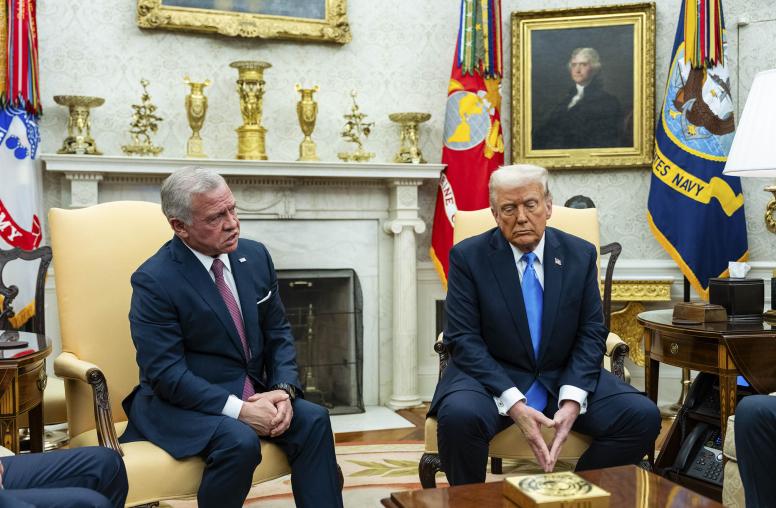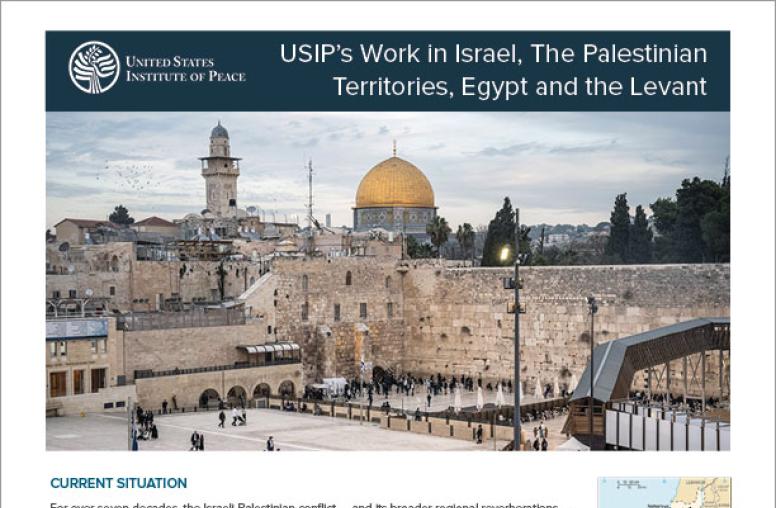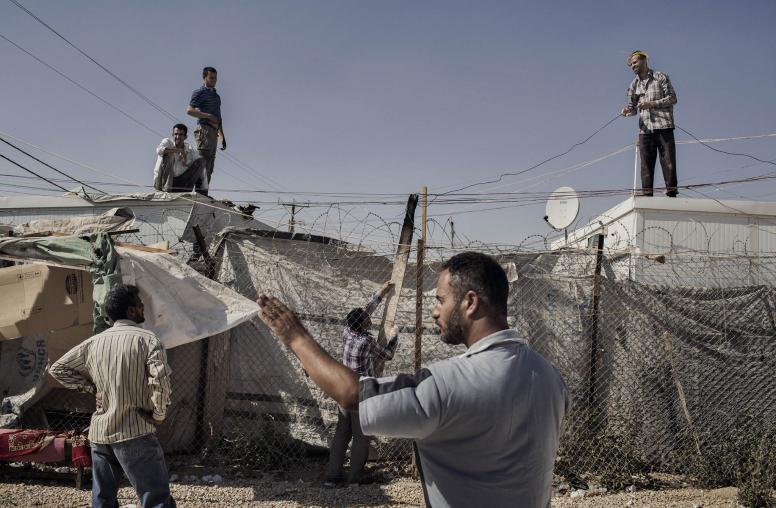Fostering Diplomatic-Defense-Development (3D) Cooperation in Responding to Complex Crises
The US diplomatic, defense, and development communities (known as the “3Ds”) increasingly find themselves working together to tackle complex crises. This collaboration has already proved its worth, but how can it be made even more effective? A recent USIP research project sought to answer that question by examining 3D collaboration in Jordan, Burma, and the Lake Chad region. This Peace Brief distills the findings of those three case studies and presents a list of five steps the US government can take to enhance the ability of the State Department, Department of Defense, and USAID to respond to complex crises.
Summary
- Increasingly, the US Department of Defense, the US Department of State, and the US Agency for International Development are working simultaneously—and sometimes collaboratively— in countries and regions marked by conflict and fragility.
- Collaboration among the 3Ds—as the US defense, diplomatic, and development communities are collectively known—is often most extensive in response to complex crises and is generally beneficial.
- The United States Institute of Peace recently examined 3D collaboration in three complex crises: Jordan, Burma, and the Lake Chad region. The case studies confirmed the value of such collaboration and generated recommendations for systematizing and improving coordination.
- Specifically, those recommendations urged the US government to
- enhance workforce preparation to increase knowledge of 3D coordination and processes;
- align planning and coordination to develop a shared framework of overarching priorities;
- creatively use existing authorities and funding, and seek exceptions, new authorities, or new funding in the face of evolving circumstances;
- allow structures and processes to adapt during crisis to meet rapidly evolving needs; and
- harness and adapt bilateral structures and tools to address transnational challenges.
Introduction
Over the past fifteen years, the US defense, diplomatic, and development communities (the 3Ds)— represented by the Department of Defense, the Department of State, and the US Agency for International Development1—have often found themselves working side by side in complex environments abroad marked by conflict, crisis, and fragility.2 In many instances, they have worked not only side by side but also hand in hand, collaborating to make their joint and individual efforts more effective. This trend raises two key questions:
- What can we learn from these critical missions undertaken in pursuit of national security?
- How can we build on experiences of closer coordination and collaboration to better systematize 3D response?
To answer these questions, the United States Institute of Peace (USIP) examined three different operating environments, each characterized by fragility, relevance to US national security, the opportunity for conflict mitigation and prevention, and an intentional and purposeful 3D response by the US government.3 In the case of Jordan, USIP studied how the 3Ds worked with a key US ally in the Middle East in 2011–16, supplementing long-term diplomatic cooperation and development assistance with extensive humanitarian assistance and military planning as conflict in Syria displaced millions and threatened regional stability. In the case of the Lake Chad region (defined as Cameroon, Chad, Niger, and Nigeria), USIP explored 3D efforts in 2013–16 in a neighborhood characterized by resource scarcity and ravaged by violent extremism that prompted the need to respond to a crossborder security and humanitarian crisis. In the third case, Burma, researchers examined collaboration and nuclear proliferation risk in a former pariah state now embarking on a democratic transformation. The investigation looked at how, from 2009 to 2015, the United States established its diplomatic and development aid presence in the country while launching binational civilian-military dialogues.
All three engagements offer lessons for working in three kinds of states: states grappling with violent extremism; states that might one day present opportunities for transition, such as Zimbabwe, Venezuela, and North Korea; and states buffeted by conflict, such as Tunisia, Algeria, and Kenya. More broadly, the research resulted in concrete recommendations for systematizing collaboration across the defense, development, and diplomatic arenas.
In Responding to Complex Crisis, Similar Obstacles Present Themselves
In all three cases, similar hurdles to 3D collaboration needed to be overcome. These included:
- Creating a shared understanding of the problems and their relative importance, as well as a common view of what key actors need to address the problems
- Balancing short-term imperatives and long-term objectives
- Balancing and reconciling top-down mandates from Washington and bottom-up field-level needs
- Identifying leadership capable of overseeing a coordinated response
- Managing the natural tension between the executive branch and Congress
- Properly sequencing the response
USIP found that when 3D leaders addressed the above challenges together, they were able to mitigate crisis and conflict while addressing shared challenges more effectively than in the past.
Joint 3D Assessments Result in Shared Goals and Objectives
In the three cases, deliberate coordination and planning brought the 3Ds and other US actors together, both in Washington, DC, and in the field, to assess the environment, develop a shared understanding of the situation on the ground, and hash out common priorities. The development of a shared “plan” was vital, as was the opportunity to collectively reassess priorities from time to time. Although myriad problems arose during execution in each location, the 3Ds never wavered from the shared assessment they had developed together to support mission-driven primary goals and objectives.
In Burma, the United States focused on fostering political change and economic liberalization, instilling respect for human rights, and promoting peace and national reconciliation. Strategic planning facilitated in Washington, DC, by a State Department special representative and policy coordinator was coupled with the introduction of an iterative, adaptive integrated embassy process for setting, communicating, and periodically reevaluating priorities. Those mechanisms provided clarity of intent that improved coordination, reduced micromanagement, increased funding flexibility, and enhanced confidence in the response within Congress and throughout the executive branch, both at the White House and within relevant departments and agencies.
In Jordan, the United States prioritized managing destabilizing internal stressors, addressing humanitarian and security needs in Syria, and preventing violent extremist activity from threatening Jordan’s security. Capable and experienced leadership was key; individuals brought experience working across the 3D agencies that enabled them to appreciate the mix of capabilities and needs, understand that special crisis structures were needed in addition to regular embassy systems, and recognize that embedding personnel from one agency in another facilitated collaboration. All of these innovations also enhanced the ability to balance immediate humanitarian imperatives with longer-term developmental and security priorities.
Within the Lake Chad region, the United States strived to degrade and defeat the terrorist organization Boko Haram so that it would no longer pose a threat to the region, mitigate Boko Haram’s impact on the region’s citizens; and address the underlying conditions that gave rise to Boko Haram. Effectiveness depended on adapting and marshaling bilateral structures and tools to address a regional challenge. Working groups, complementary programs, joint exercises, and integrated planning were all used to enable 3D cooperation that helped clear Boko Haram from some areas and prevent its incursion into other areas, delivered humanitarian relief, and enhanced local capacity to govern and meet basic needs.
Where 3D Coordination Is Strong, Progress Prevails
Although US 3D actors are still pursuing long-term goals in Jordan, Burma, and the Lake Chad region, in each case progress toward stated goals and objectives occurred as a result of deliberate, coordinated action. Burma evolved from a pariah state to a nation that held elections in 2015 and is undergoing a fragile democratic transition.4 Jordan largely weathered Syria’s implosion and the resulting tide of refugees and burgeoning violent extremism. In the Lake Chad region, Boko Haram was transformed from a murderous multistate threat to an organization that is on the run and largely contained to small pockets of territory. To be sure, serious challenges remain and backsliding is likely to persist. Nonetheless, the studies found that US government leaders believe that collaborative interagency engagement prevented the crises from deepening and that a solid foundation for future cooperation was created through a multifaceted, coordinated 3D response.
A Better Way to Tackle Fragility?
In 2016, the Fragility Study Group, led by USIP, the Center for a New American Security, and the Carnegie Endowment for International Peace, found that the United States could be more effective if its defense, development, and diplomatic institutions worked together toward shared goals in fragile states. The Fragility Study Group recommended a strategic, selective, systemic, and sustained response to fragile states. USIP’s study of the trio of 3D cases similarly spotlighted the value of collaboration and of tackling “security, political, and capacity challenges in relationship to one another and not in isolation.”5
Although focused on complex crisis response, this recent investigation found that policymakers often sought to address long-term challenges even as they met short-term needs. In Jordan, for example, short-term humanitarian response efforts ramped up even as programs continued to address chronic economic deprivation and water scarcity in areas not affected by crisis. Moreover, innovative efforts combined development aid with humanitarian assistance to increase the resilience of refugee-affected communities. In the Lake Chad region, resilience programs fostering economic development and good governance overlay efforts to directly counter Boko Haram and other extremist groups, unified objectives, and close coordination enabled complementary programming.
The case studies revealed instances in which crisis response coordination created relationships and structures useful for tackling fragility over the long term. For example, to better tackle the reality that refugees are often displaced for protracted periods of time, resilience programming in Jordan began to address “community resilience,” which forced program planners to consider refugees, not just Jordanians, as beneficiaries of longer-term development assistance.
Similarly, cooperation among 3D leaders benefited from and helped expand the cadre of senior officials equipped with a keen understanding of the different organizations and their priorities. Senior leaders from each of the 3D communities brought experience working across the 3Ds, as well as at least some experience in conflict and crisis response. That experience enabled them to agree on the dimensions of fragility in a particular context and provided a foundation for interweaving efforts to promote stronger state-society relationships. The collaborative experiences also enabled emerging leaders working with them to learn the value and benefits of coordination and collaboration.
Recommendations
What steps can the US government take to enhance and better enable coordination and collaboration among the 3Ds as they respond to the immediate demands of complex crises while also addressing fragility over the long term? The answer, according to the three case studies, is a set of actionable steps focused on staffing, planning, and funding.
Enhance workforce preparation by making 3D experience and interagency rotations a professional requirement. The three case studies revealed that leaders and personnel exposed to only a single department were more likely to see problems through a funnel, with a narrow focus on their own department’s tools and processes. Leaders with previous 3D knowledge and exposure proved better equipped to work with one another to prevent or mitigate crisis. On-the-job collaboration, training, and education, as well as interagency rotations, helped leaders move quickly and purposefully when crises worsened; that cross-specialization learning also enabled them to leverage other institutions’ capabilities at pivotal moments.
Use joint planning and coordination to create a shared understanding of the operating environment and to forge common priorities. In analyzing the three cases, it became clear that the US government does not have sufficient processes for joint planning—a shortcoming that is particularly evident when crises escalate. Standard department-specific frameworks often force resources and programs into long-term commitments, which inhibit the realignment of those resources and programs during crisis. The sudden need for US organizations that have not planned together to work together often risked confusion, lack of coordination, lost resources, wasted time, and even lives. Even when processes were ad hoc, the act of planning together helped agencies advance clear priorities; reject ideas for programs and activities that were inconsistent with priorities; identify obstacles while spotting leverage points; and unearth opportunities for leveraging allies, multilateral institutions, and the private sector. Extensive joint planning helped align and communicate priorities to all involved, and established a process for information sharing among stakeholders so that each understood what the others were doing.
Enable the creative use of existing authorities and funding—and seek exceptions, new authorities, or new funding—to confront crises amid changing circumstances. In Jordan, Burma, and the Lake Chad region, budgetary cycles proved too long to account for the volatility of complex crises. Restrictive authorities and earmarks governing the allocation of funds risked hamstringing implementers, and the accelerated operational tempo precluded employing the typically drawn-out processes of consultation and guidance to alter authorities. Discretionary funding such as Economic Support Funds, and flexible accounts such as USAID’s Transition Initiatives account, empowered 3D leaders to respond to new or unforeseen developments. Carve-outs from or exceptions to existing authorities also helped ensure bureaucratic barriers did not impede progress. That said, the ability to act creatively depended on building congressional and executive branch trust in 3D leadership. It also depended on ensuring the appropriate level of resources.
Allow the 3Ds to adapt the foreign policy machinery during crisis. In each of the cases studied, emergent events often outpaced the ability of US structures and processes to adapt, even when there were experienced leaders, clear priorities, authorities, and funding in place. Real-time adjustments to staffing, implementation mechanisms, structures, and processes proved necessary to meet rapidly evolving crises. Co-location of the 3Ds, purposeful layering of funding streams and authorities to achieve impact, and the embedding of personnel from one department in another often created efficiencies and helped ensure unity of effort. Success required both empowered leadership in the field and robust structures in Washington, DC; field- and Washington-based leadership needed to work as two parts of a whole, as complements and in partnership.
Harness bilateral assets to address transnational challenges. US foreign policy remains bilaterally focused and ill equipped to tackle transnational issues. Foreign and security assistance and diplomatic influence are typically delivered bilaterally, while effective US responses often require the pursuit of regional objectives; many crises are driven and exacerbated by nonstate actors and regional dynamics. During a crisis, the 3D institutions should bring together teams that normally work via bilateral engagement mechanisms to align activities and budgets so that they can serve transnational priorities.
Conclusion
The US government needs to better adapt to a world in which defense, diplomatic, and development programs are increasingly undertaken in the same locations at the same time. Enabling greater coordination and collaboration will pay dividends for stability and security; programs will be better conceived and more successfully sequenced and delivered, with commensurate improvements to the durability and value of projects and investments.
Notes
- According to the USAID, State, and DoD 3D Planning Guide, “Diplomacy, Development, and Defense (3Ds)—as represented by the Department of State (State), the United States Agency for International Development (USAID), and the Department of Defense (DoD or Defense)—are the three pillars that provide the foundation for promoting and protecting U.S. national security interests abroad.” See 3D Planning Guide: Diplomacy, Development, Defense (USAID, July 2012), 4, www.usaid.gov/documents/1866/diplomacy-development-defense-planning-guide.
- “Fragility is the absence or breakdown of a social contract between people and their government. Fragile states suffer from deficits of institutional capacity and political legitimacy that increase the risk of instability and violent conflict and sap the state of its resilience to disruptive shocks.” Fragility Study Group, “U.S. Leadership and the Challenge of State Fragility” (Washington, DC: Center for a New American Security, Carnegie Endowment for International Peace, and United States Institute of Peace, September 2016), 5, www.usip.org/sites/default/files/US-Leadership-and-the-Challenge-of-State-Fragility.
- The three case studies—all written by Beth Ellen Cole, Alexa Courtney, Erica Kaster, and Noah Sheinbaum—were published by USIP in September 2017: “From Pariah to Partner: The US Integrated Reform Mission in Burma, 2009 to 2015,” www.usip.org/3dlessons/burma; “Breaking Boko Haram and Ramping Up Recovery: US Engagement in the Lake Chad Region, 2013 to 2016,” www.usip.org/3dlessons/lakechadregion; and “Preserving Stability amidst Regional Conflagration: US Engagement in Jordan, 2011 to 2016,” www.usip.org/3dlessons/jordan.
- The study of Burma examines the period 2009–15; it does not examine the onset of the Rohingya crisis that began in September 2017 or the US response to that crisis.
- Fragility Study Group, “U.S. Leadership and the Challenges of State Fragility. ”
About this Brief
This Peace Brief examines the lessons from the collaboration of the US defense, diplomatic, and development communities (the 3Ds) in three complex crises and recommends a set of actionable steps focused on staffing, planning, and funding to enhance future coordination and collaboration. Beth Cole is an independent consultant, who previously served as special adviser for violent extremism, conflict, and fragility at USIP. Carla Koppell is the vice president for the Center for Applied Conflict Transformation at USIP. She previously was chief strategy officer for USAID.



